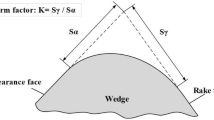Abstract
One way of achieving a successful forest management leading to biodiversity conservation is to ensure that wood is processed in an efficient manner. The authors succeeded in developing a new technology for bandsawing using a tip-inserted saw. The material used for the tipped edge was High Speed Steel (HSS) of designation SHK 51 according to the Japan Industrial Standard (JIS). The efficiency of the tip-inserted saw was investigated considering its effectiveness in controlling tooth marks and washboarding patterns that sometimes occur during bandsawing. The surface profile of the workpiece generated after sawing with 700 mm and 1100 mm diameter bandmills of the laboratory and industrial type respectively were determined using a CCD laser displacement sensor of scanning length 250 mm and scanning speed of 3 mm/sec at a sampling rate of 50 Hz. Under a setup wheel rotation speed of 200 rpm and feed speed of 1 m/min, washboardings were induced during sawing with the tip-inserted saw of uniform pitch. Thereafter, a tip-inserted saw of random pitch was constructed without removing the saw from the pulley and cutting tests were performed under the same cutting conditions when washboardings were induced during sawing with the uniform pitch tipped-inserted saw. It was observed that the washboarding pattern disappeared completely. Thus the tip-inserted saw of random pitch was very effective in controlling the washboarding pattern. Comparisons of the surface profiles of the workpiece generated by sawing with uniform pitch tip-inserted and stellite-tipped saws under both laboratory and industrial conditions indicate that regardless of the type of bandmill used, the surface profile measured with the laser displacement sensor was smoother for tip-inserted saws than stellite-tipped saws.
Zusammenfassung
Für eine erfolgreiche Waldwirtschaft mit dem Ziel der Erhaltung der Artenvielfalt ist es erforderlich, das Holz effizient zu verarbeiten. Letzteres gelang den Verfassern mit der Entwicklung einer neuen Bandsägetechnik unter Verwendung eines mit Hartmetall-Schneidplatten bestückten Sägeblatts. Für diese Bestückung wurde Hochgeschwindigkeitsstahl (HSS) nach japanischer Industrienorm JIS mit der Bezeichnung SHK51 verwendet. Die Effektivität des mit Hartmetall bestückten Sägeblatts wurde im Hinblick auf die Vermeidung von Zahnspuren und Waschbrettprofilen geprüft, welche manchmal bei diesem Sägevorgang auftreten. Das Oberflächenprofil des Schnittholzes nach dem Sägen mit einer 700 mm Laborbandsäge und einer 1100 mm Industriebandsäge wurde mittels eines CCD-Laser Sensors mit 250 mm Abtastlänge und einer Abtastgeschwindigkeit von 3 mm/sek bei einer Messwerterfassung von 50 Hz bestimmt. Bei einer Bandgeschwindigkeit von 200 rpm und einer Vorschubgeschwindigkeit von 1 m/min entstanden während des Sägevorgangs mit einer gleichmässig mit Hartmetall-Schneidplatten bestückten Säge Waschbrettprofile. Daraufhin wurde ein Sägeblatt mit zufälliger Anordnung der Bestückung hergestellt, ohne dieses auszubauen. Damit wurden Schnittversuche unter den genau gleichen Bedingungen wie bei den zuvor durchgeführten Versuchen mit einem gleichmässig bestückten Sägeblatt durchgeführt, bei denen Waschbrettprofile entstanden waren. Dabei verschwand das Waschbrettmuster vollkommen. Somit war das Sägeblatt mit zufällig angeordneter Bestückung sehr wirksam für die Vermeidung von Waschbrettprofilen. Vergleiche der mit dem Lasersensor gemessenen Oberflächenprofile von Proben nach dem Sägen mit Hartmetall-Schneidplatten bestückten Sägeblättern bei einheitlicher Teilung und stellitierten Sägeblättern zeigten sowohl unter Labor- als auch unter Industriebedingungen, dass ungeachtet des Typs der verwendeten Bandsäge die Oberflächen des mit Hartmetall-Schneidplatten bestücktem Sägeblatt bearbeiteten Holzes glattere Oberflächen aufwiesen als Proben, die mit stellitiertem Sägeblatt eingeschnitten wurden.
Similar content being viewed by others
References
Hutton SG, Zhang JJ (1989) The causes of washboarding in bandsaws. In: Proceedings of SawTech, Oakland, California, USA, pp 12.1–12.10
Hutton SG, Dalziel MC (2003) Analysis of washboarding in bandsaws. In: Proceedings of the 16th international wood machining seminar. Matsue, Japan, pp 268–277
Kimura S, Sakakibara K, Yokochi H (1999) Remodeled bandsaw to control washboarding during sawing. In: Proceedings of the 14th international wood machining seminar. Paris, France, pp 163–172
Kimura S, Yokochi H, Edamura M, Kojima Y (2001) Remodeled bandsaw to control washboarding during sawing. In: Proceedings of the 15th international wood machining seminar. Los Angeles, California, USA, pp 199–204
Lehmann BF, Hutton SG (1997) The kinematics of washboarding of bandsaws and circular saws. In: Proceedings of the 13th international wood machining seminar, Vancouver, Canada, pp 205–216
Luo Z, Chen G, Hutton SG (2001) Experimental study on washboarding in wide bandsaws. In: Proceedings of the 15th international wood machining seminar. Los Angeles, California, pp 205–217
Luo Z, Taylor J, Hutton S, White J (2003) An experimental investigation into washboarding in bandsaws. In: Proceedings of the 16th international wood machining seminar. Matsue, Japan, pp 257–267
Okai R, Kimura S, Yokochi H (1995) What is the relationship between tooth passage frequency and natural frequency of the bandsaw when self-excited vibration and washboarding are induced in bandsaws? In: Proceeding 12th international wood machining seminar, pp 367–380
Okai R, Kimura S, Yokochi H (1996) Dynamic characteristics of the bandsaw. I. self-excited vibration and washboarding during cutting. Mokuzai Gakkaishi 42(4):333–342
Okai R, Kimura S, Yokochi H (1997) Dynamic characteristics of the bandsaw III (1997) Effects of workpiece thickness and its position from the ground on self-excited vibration and washboarding during sawing. Mokuzai Gakkaishi 43(7):551–557
Orlowski K, Wasielewski R (2001) Wasboarding during cutting on frame sawing machine. In: Proceedings of the 15th international wood machining seminar. Los Angeles, California, pp 219–228
Orlowski K, Wasielewski R (2003) Washboarding during cutting on frame sawing machines II. Experimental study of the saw blade behaviour. In: Proceedings of the 16th international wood machining seminar. Matsue, Japan, pp 278–287
Tanaka C, Okai R, Iwasaki Y, Sandak J, Ohtani T, Hu C, Iskra P, Xuequn L (2003) Development of a new technology for bandsawing using a tip-inserted saw part 1. Consideration of tool hardness, cutting tool wear and accuracy of kerf width. For Prod J (Accepted)
Yokochi H, Kimura S, Edamura M, Kojima Y (2003) Remodeled bandsaw to control washboarding during sawing. In: Proceedings of the 16th international wood machining seminar. Matsue, Japan, pp 595–604
Author information
Authors and Affiliations
Corresponding author
Rights and permissions
About this article
Cite this article
Okai, R., Tanaka, C., Ohtani, T. et al. Application of a novel technique for band sawing using a tip-inserted saw regarding surface profiles. Holz Roh Werkst 63, 256–265 (2005). https://doi.org/10.1007/s00107-005-0023-6
Published:
Issue Date:
DOI: https://doi.org/10.1007/s00107-005-0023-6




